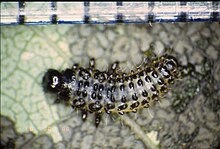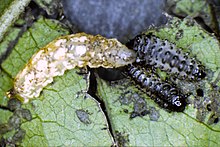Phratora vitellinae
One way to distinguish among adult Phratora beetles co-occurring on the same host plant is to gently squeeze the abdomen of females until the morphology of the genitalia can be observed from the ventral side.
Phratora vitellinae females possess a wide smooth sclerotized plate running parallel to the posterior of the abdomen.
The Brassy Willow Beetle is larger and more abundant[17][18] than P. atrovirens and somewhat broader in body shape than P. laticollis.
[1][19] In Europe, it is found in Arctic regions and the Nordic countries,[20][21] the United Kingdom,[22][13] Germany[18][2] to Spain,[23] Serbia and Bosnia.
[34] Adults may be consumed by predatory insects or birds,[35][36] and they may succumb to infection by the fungus Beauveria bassiana[5] or nematodes.
[37][38] Eggs of P vitellinae are consumed by the syrphid fly Parasyrphus nigritarsis and probably are eaten by predaceous bugs and mites.
Phratora vitellinae sequesters host plant salicylates to make its larval defensive secretion.
Most Phratora species possess the ancestral trait of synthesizing iridoid monoterpene larval defensive secretions themselves (autogeneously), independent of the secondary chemistry of the host plant.
[47][8] As noted above, P. vitellinae is widespread and common and has an unusual mechanism for metabolizing host plant secondary compounds to make its own defensive secretion.
Both of the salicylate poor species have dense hairs or trichomes on the undersides of their leaves, which might repel P. vitellinae.
On the other hand, these hosts are favored and frequently used by Phratora vulgatissima,[4] which suggests that the beetles can overcome the potential physical defense of leaf trichomes.
Tahvanainen et al. (1985) published a study of host plant preferences among native and introduced Finnish willows that varied in phenolglycoside chemistry for four species of leaf beetles occurring in Finland, including P.
[32] The researchers considered leaf texture to be a less important trait for the beetle than the chemistry of the host leaves.
They also noted that Salix pentandra was relatively unpalatable, possibly because it contained high levels of a phenolglycoside not found in the other willows.
Denno et al. (1990)[10] hypothesized that the host plant use of P. vitellinae would be based on levels of salicylates in the leaves and that higher predation from natural enemies on salicylate-poor plants would generate a selection pressure favoring leaf beetle specialization on willows with higher salicylates.
Early studies of natural enemies of P. vitellinae and its relatives in the laboratory and field were conducted by V. Kanervo in Finland.
[39][49][50] The larval secretion of P. vitellinae contains salicylaldehyde, an irritating volatile compound that was shown to repel ants in the laboratory.
Rank et al. (1998)[12] compared predation success on the salicylate-rich Salix myrsinifolia and the salicylate-poor Salix phylicifolia for three predators that have been observed feeding on P. vitellinae larvae in nature; the bugs Anthocorus nemorum and Rhacognathus punctatus and the hover fly Parasyrphus nigritarsis.
In support of this hypothesis, it was shown that secretions produced by larvae deter egg laying by females.
[58][54] Phratora species can be considered pests if their population density increases substantially in Populus and willow (Salix) plantations.
[59][5][31] Methods of controlling P. vitellinae populations that damage plantation trees include chemical control,[59][5] habitat modifications such as flooding plantations to reduce numbers of overwintering adults or pupae,[5] breeding resistant plants,[60][61][62] or generating genetically modified strains of plants that show resistance to insect herbivores.








